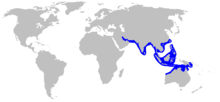| Winghead shark | |
|---|---|

| |
| Scientific classification | |
| Domain: | Eukaryota |
| Kingdom: | Animalia |
| Phylum: | Chordata |
| Class: | Chondrichthyes |
| Subclass: | Elasmobranchii |
| Order: | Carcharhiniformes |
| Family: | Sphyrnidae |
| Genus: | Eusphyra T. N. Gill, 1862 |
| Species: | E. blochii
|
| Binomial name | |
| Eusphyra blochii (G. Cuvier, 1816)
| |

| |
| Range of the winghead shark[3] | |
| Synonyms | |
| |
The winghead shark (Eusphyra blochii) is a species of hammerhead shark, and part of the family Sphyrnidae. Reaching a length of 1.9 m (6.2 ft), this small brown to gray shark has a slender body with a tall, sickle-shaped first dorsal fin. Its name comes from its exceptionally large "hammer", or cephalofoil, which can be as wide as half of the shark's total length. The function of this structure is unclear, but may relate to the shark's senses. The wide spacing of its eyes grants superb binocular vision, while the extremely long nostrils on the leading margin of the cephalofoil may allow for better detection and tracking of odor trails in the water. The cephalofoil also provides a large surface area for its ampullae of Lorenzini and lateral line, with potential benefits for electroreception and mechanoreception, respectively.
Inhabiting the shallow coastal waters of the central and western Indo-Pacific, the winghead shark feeds on small bony fishes, crustaceans, and cephalopods. It gives birth to live young, with the developing embryos receiving nourishment through a placental connection. Females produce annual litters of six to 25 pups; depending on region, birth may occur from February to June after a gestation period of 8–11 months. This harmless species is widely fished for meat, fins, liver oil, and fishmeal. The International Union for Conservation of Nature has assessed it as endangered in 2016, as it is thought to have declined in some parts of its range due to overfishing.
- ^ Smart, J.J.; Simpfendorfer, C. (2016). "Eusphyra blochii". IUCN Red List of Threatened Species. 2016: e.T41810A68623209. doi:10.2305/IUCN.UK.2016-1.RLTS.T41810A68623209.en. Retrieved 19 November 2021.
- ^ "Appendices | CITES". cites.org. Retrieved 14 January 2022.
- ^ Cite error: The named reference
last and stevenswas invoked but never defined (see the help page).
